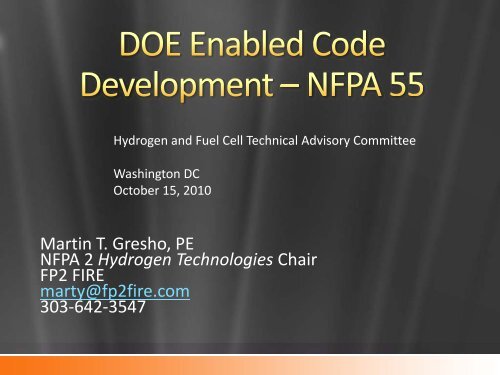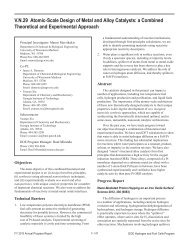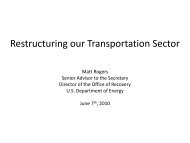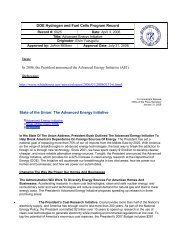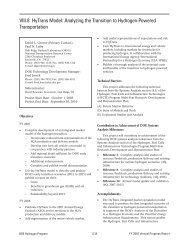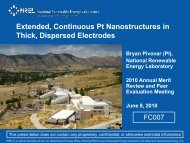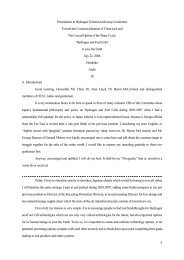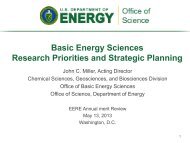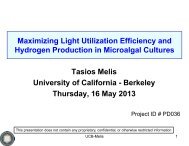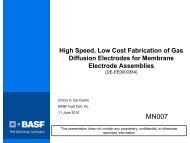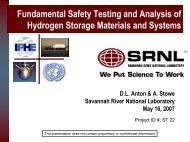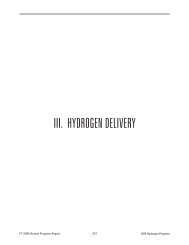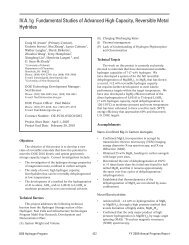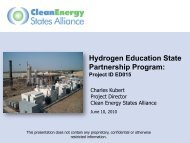DOE Enabled Code Development - DOE Hydrogen and Fuel Cells ...
DOE Enabled Code Development - DOE Hydrogen and Fuel Cells ...
DOE Enabled Code Development - DOE Hydrogen and Fuel Cells ...
You also want an ePaper? Increase the reach of your titles
YUMPU automatically turns print PDFs into web optimized ePapers that Google loves.
<strong>Hydrogen</strong> <strong>and</strong> <strong>Fuel</strong> Cell Technical Advisory Committee<br />
Washington DC<br />
October 15, 2010<br />
Martin T. Gresho, PE<br />
NFPA 2 <strong>Hydrogen</strong> Technologies Chair<br />
FP2 FIRE<br />
marty@fp2fire.com<br />
303‐642‐3547
<strong>Code</strong> Developer<br />
Chair of NFPA 2 –<strong>Hydrogen</strong> Technologies<br />
Member of NFPA 55 – Compressed Gas<br />
Member of NFPA 400 – Hazardous Materials<br />
Participant in International <strong>Code</strong> Council<br />
development hearings – IBC, IFC model codes<br />
Fire Marshal at S<strong>and</strong>ia CA (15 years) – <strong>Code</strong><br />
Enforcer<br />
Licensed Fire Protection Engineer
Research Informed <strong>Code</strong> <strong>Development</strong><br />
Synopsis of Traditional Methods<br />
Research based.<br />
NFPA 55 Separation Distances<br />
<strong>DOE</strong> R&D Lab assisted<br />
Success Story<br />
NFPA 2 –<strong>Hydrogen</strong> Technologies<br />
Status in <strong>Code</strong> Cycle<br />
Predicted Publication Date
NFPA C&S <strong>Development</strong> Process<br />
ANSI Approved
Built Environment <strong>Code</strong>s are Prescriptive (BEST)<br />
Example: Locate bulk GH2 storage 50 ft. from sidewalks<br />
Easy to enforce<br />
Easy to comply<br />
Hard to codify<br />
Alternative Approach –Goal Oriented Analysis<br />
Example: Perform analysis to determine the acceptable separation<br />
distance.<br />
Need mutual agreement to proceed (<strong>Code</strong> Official)<br />
Agree on: Acceptance criteria, scenarios.<br />
Perform analysis<br />
Review analysis (3 rd party consultant)<br />
Accept results <strong>and</strong> ID new<br />
Easy to codify –hard <strong>and</strong> expensive to use
Experience Based <strong>Development</strong><br />
Relies on experience of members<br />
Precedence<br />
Relatively easy <strong>and</strong> fast<br />
Work well but ONLY when there is experience (loss<br />
history)<br />
Lacking scientific research to PREDICT results new code<br />
is likely to be either:<br />
Prescriptive – conservative OR<br />
Alternative Analysis based
Traditional Experienced Based Method<br />
Codification start date ‐ ~ 6 months prior to<br />
Proposal deadline<br />
Research Informed Method<br />
Codification starts after research results published <strong>and</strong> peer<br />
reviewed.<br />
Codification start date ‐ ~ 2 years prior to Proposal deadline
Research results should be targeted to a<br />
specific code or st<strong>and</strong>ard<br />
Codification effort should be timed to a specific<br />
cycle<br />
TC needs assistance. Research needs to be<br />
supported throughout the code development<br />
process.
NFPA 55 lists separation distances between bulk<br />
GH2 storage <strong>and</strong> various exposures since 1950<br />
• ~2003 Concern voiced about the basis for the<br />
distances<br />
• ~2003 – 2007 S<strong>and</strong>ia developed mathematical<br />
models of GH2 releases<br />
• Model validated with physical testing ‐ critical<br />
• Results presented to NFPA 55
Full Technical Committees (~30 members each) met <strong>and</strong><br />
Established Task Groups [NFPA 2 11/06; NFPA 55 01/07<br />
13 TC members from NFPA 55 <strong>and</strong>/or 2 + 2 SNL R&D<br />
Task group deliberations<br />
4 in‐person multiple day meetings<br />
12 + telecons<br />
S<strong>and</strong>ia researchers provided support for task group<br />
Iterations on mathematical model<br />
<strong>Development</strong> of SAND report on risk informed method –<br />
part of documented basis.<br />
S<strong>and</strong>ia researchers did not provide code text.<br />
Task group product = proposal to NFPA 55
Result –code proposal with defensible basis accepted by NFPA<br />
55 TC <strong>and</strong> published in 2010 edition –now available<br />
<strong>DOE</strong> Support summary<br />
Initial research<br />
Physical Testing<br />
Mathematical model<br />
Risk Expertise<br />
Technical Support through public review<br />
<strong>DOE</strong> DID NOT WRITE THE CODE<br />
This change was widely supported but would NOT have been<br />
possible w/o <strong>DOE</strong> support!! ENABLING<br />
Thank You <strong>DOE</strong>!!
New code with all hydrogen requirements<br />
Consolidates requirements from multiple NFPA<br />
codes <strong>and</strong> st<strong>and</strong>ards<br />
Upon issuance will simplify construction permits<br />
<strong>and</strong> regulation of hydrogen in built environment<br />
<strong>DOE</strong> provided seed funding<br />
3 pre ROP meetings, ROP, ROC ‐ all complete 4<br />
year process
NFPA 2 Status<br />
~6/2011<br />
NFPA 2<br />
~12/2010
NFPA 55 was a success story – supported by many – enabled<br />
by <strong>DOE</strong><br />
The process to codify research results can serve as a model<br />
Scientific results<br />
Expert judgment<br />
Codification plan<br />
<strong>Code</strong> development can be strengthened by research<br />
Research is one project<br />
Codification is another –special skill<br />
<strong>Code</strong> development process is regimented <strong>and</strong> not fast<br />
Combining research results with codes = better public safety


